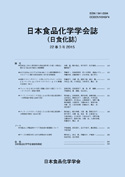Volume 9, Issue 3
Displaying 1-7 of 7 articles from this issue
- |<
- <
- 1
- >
- >|
Regular articles
-
Article type: Article
2002 Volume 9 Issue 3 Pages 89-94
Published: December 30, 2002
Released on J-STAGE: December 01, 2017
Download PDF (767K) -
Article type: Article
2002 Volume 9 Issue 3 Pages 95-100
Published: December 30, 2002
Released on J-STAGE: December 01, 2017
Download PDF (713K) -
Article type: Article
2002 Volume 9 Issue 3 Pages 101-106
Published: December 30, 2002
Released on J-STAGE: December 01, 2017
Download PDF (730K) -
Article type: Article
2002 Volume 9 Issue 3 Pages 107-113
Published: December 30, 2002
Released on J-STAGE: December 01, 2017
Download PDF (731K) -
Article type: Article
2002 Volume 9 Issue 3 Pages 114-119
Published: December 30, 2002
Released on J-STAGE: December 01, 2017
Download PDF (833K) -
Article type: Article
2002 Volume 9 Issue 3 Pages 120-124
Published: December 30, 2002
Released on J-STAGE: December 01, 2017
Download PDF (604K) -
Article type: Article
2002 Volume 9 Issue 3 Pages 125-130
Published: December 30, 2002
Released on J-STAGE: December 01, 2017
Download PDF (855K)
- |<
- <
- 1
- >
- >|
